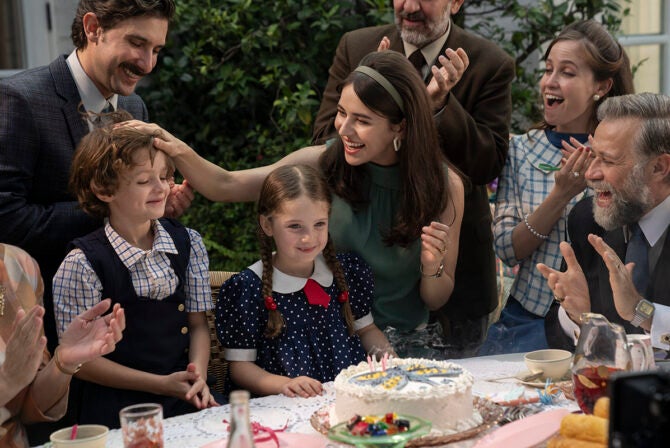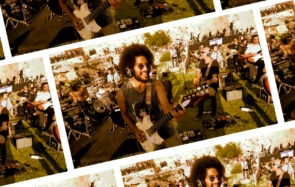I was raised in a totally non-observant home. I grew up with Christmas trees, not because we were celebrating the birth of Jesus but because my Mom needed a place to hang her Elvis elves and pickle ornaments. I only went to synagogue a handful of times growing up–mostly for a cousin’s bar or bat mitzvah–and it wasn’t until high school that I paid enough attention to realize that the prayer book opened the wrong way. My Hebrew fluency consisted of “shalom” and “schmuck” (which, as my husband points out, is actually Yiddish).
Needless to say, I knew nothing about living in a Jewish home, much less how to create one. Yet here I am, a proud Jewish mother of two girls, and my husband and I keep a Jewish home together. We belong to a synagogue, keep kosher (mostly), observe Shabbat, and sing the Shema with our daughters at bedtime. I’ve come a long way from a childhood of agnostic Easter eggs.
I’ve always been interested in religion and spirituality, and spent many years looking for the right fit. In high school I hung out with Christian kids, in college I studied Buddhism and Hinduism. It was all interesting, but none of it really made sense to me in the way that faith and culture should. None of it fit. Then one day it occurred to me that I ought to consider my own heritage. I found a copy of Jewish Literacy by Joseph Telushkin, and I was hooked. I had found my home. I kept reading, and after several months, I decided I needed to start living a Jewish life.
But How?
Finding my place in the Jewish community, and creating a Jewish space in my life, hasn’t always been easy. I have often felt like an outsider, and part of me wanted to just keep reading alone at home instead of getting out of the house to connect with real live Jews. But I knew that connecting with other Jews was crucial. Judaism doesn’t expect you to do it alone–in fact, Jewish rituals require us to come together to pray, welcome new life, mourn losses, and celebrate holidays. If you really want to create a Jewish home, you have to be willing to step outside of it and into the greater Jewish community.
 Unfortunately, not every community is as welcoming to us Jewbies (Jewish Newbies, of course) as one would hope. My first attempt at finding a synagogue failed miserably. I called a local temple looking for information about services. I was told that Erev Shabbat (or eve of Shabbat) services start at 8 pm, and I could just show up. I had no idea what Erev Shabbat was–I was looking for Friday night services. Furthermore, where exactly was I supposed to go? What should I wear? I was overwhelmed, and never actually went.
Unfortunately, not every community is as welcoming to us Jewbies (Jewish Newbies, of course) as one would hope. My first attempt at finding a synagogue failed miserably. I called a local temple looking for information about services. I was told that Erev Shabbat (or eve of Shabbat) services start at 8 pm, and I could just show up. I had no idea what Erev Shabbat was–I was looking for Friday night services. Furthermore, where exactly was I supposed to go? What should I wear? I was overwhelmed, and never actually went.
I wish I had known then that every community is different, and some synagogues really are more accessible to those of us who didn’t go to Hebrew school or Jewish summer camp. The synagogue my husband and I ultimately joined is incredibly thoughtful about these issues. Our Rabbi is easy to follow, and the prayer book has the major prayers transliterated so I can participate even though I read Hebrew about as well as my 2-year-old. I have attended a number of classes explaining the meaning behind services, holidays, and rituals.
Judaism Beyond the Synagogue
Fortunately, our synagogue isn’t my only connection to Judaism. My husband was raised in a Jewish home and attended Jewish day school and summer camp. He reads Hebrew, knows all the songs, and reminds me of which blessing to say before meals. He’s very supportive, but I still feel annoyed when he points out where we are in the prayer book during services – I already feel like enough of an imposter, thank you very much! More often than not, however, we fill in the gaps for each other; I light the candles on Shabbat (he doesn’t like lighters), and he blesses our daughters (I can’t remember the words).
I remember our first Shabbat as a couple, about eight years ago. We had just moved in to our own apartment, and I went to a Judaica shop and purchased a set of candlesticks, a Kiddush cup, and a challah knife. I was sure I was setting the table wrong, but Josh insisted it was just right. I can’t remember who said the blessings (probably Josh), or exactly how it went, but I do recall bursting into tears. After almost two years of hiding behind books and wanting so desperately to really feel Jewish, celebrating Shabbat with the man who would become my husband was an incredibly powerful experience. I knew I had a long way to go, but I was getting closer.
My Jewish identity has strengthened considerably over the years, but there are still times when I expect the Rabbi to call me out in the middle of services. During both of our daughter’s naming ceremonies, I stumbled over the Hebrew blessings, and once again felt that awkward combination of embarrassment and longing that had caused me to avoid services so many years before.
Kids Change Things
Having children has taken my Jewish education in an entirely different direction, a much more powerful one. Before I had kids my understanding of Judaism was almost entirely intellectual. Now we listen to music, squeeze stuffed Torahs, paint menorahs, play games, and eat traditional foods. These activities connect me to Jewish history and culture in an experiential, visceral way – something I never found in a book, or even in services.
The one thing I have learned over the years is that being Jewish isn’t about what you do or how you do it. It’s about who you are, and how you choose to stay connected to Judaism. The real joy of living Jewishly is about finding and creating meaning in our shared history, culture, and faith, which at times can be as simple as reminding your toddler not to feed the dreidel to her little sister.







